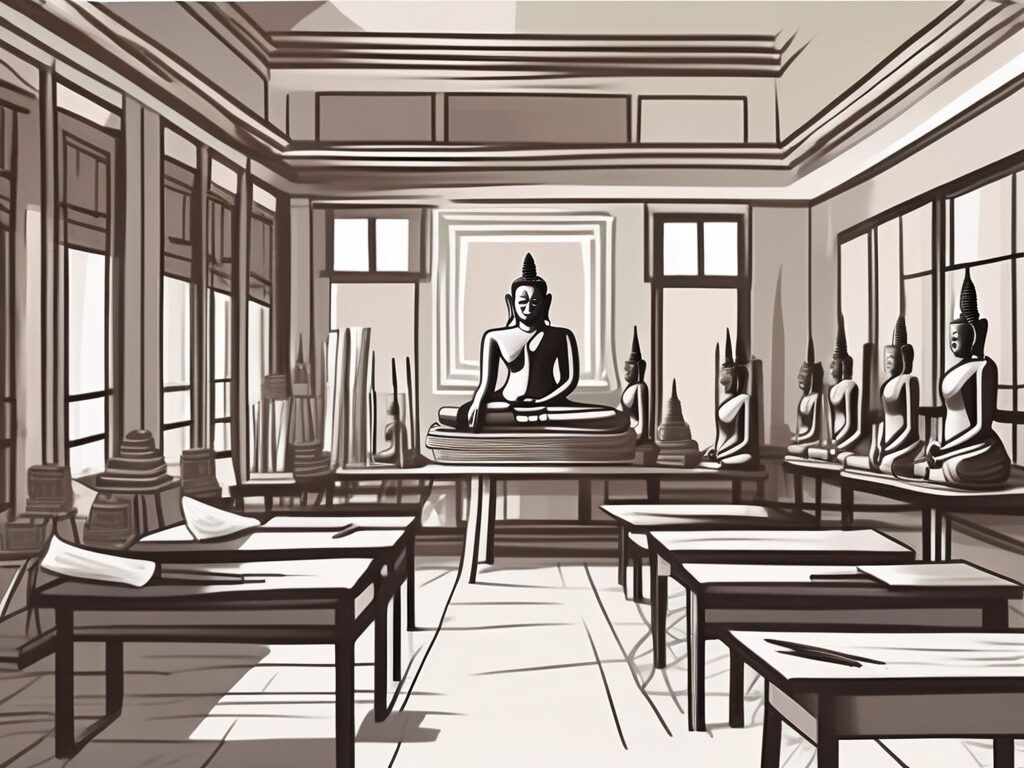The arts and humanities sector in Cambodia has seen a significant resurgence in recent years, with a growing interest in preserving and promoting the country’s rich cultural heritage. This has led to an increased emphasis on arts and humanities education, providing a platform for the next generation of Cambodian artists, historians, and cultural leaders.
The Current State of Arts and Humanities Education
The current landscape of arts and humanities education in Cambodia is a fascinating blend of tradition and innovation. On one hand, there is a strong focus on traditional Cambodian arts, such as classical dance, shadow puppetry, and Khmer literature. On the other hand, there is an increasing interest in contemporary arts and global humanities studies.
Many educational institutions, both public and private, offer programmes in the arts and humanities. These range from primary and secondary schools incorporating arts education into their curriculum, to universities offering specialised degrees in various arts and humanities disciplines.
Challenges and Opportunities
Despite the growing interest, arts and humanities education in Cambodia faces several challenges. Limited resources, lack of trained teachers, and a societal emphasis on more ‘practical’ fields of study such as business and technology can often overshadow the importance of arts and humanities.
However, these challenges also present opportunities. The need for trained teachers can lead to job opportunities for artists and scholars. Additionally, the integration of technology in arts education can create a unique blend of tradition and innovation, making Cambodian arts and humanities education distinct and attractive on a global scale.
The Role of Non-Profit Organisations
Non-profit organisations play a crucial role in promoting arts and humanities education in Cambodia. These organisations often provide resources, training, and platforms for young artists and scholars to showcase their work.
For example, organisations like the Cambodian Living Arts work towards the preservation and promotion of traditional Cambodian arts. They offer scholarships, organise festivals, and run arts education programmes in schools.
International Collaboration
Many non-profit organisations also facilitate international collaborations, providing Cambodian artists and scholars with global exposure. These collaborations often result in cross-cultural exchange, enriching the arts and humanities education in Cambodia.
For instance, the Phare Ponleu Selpak, a non-profit arts school, regularly collaborates with international artists and institutions. This not only enhances the learning experience for their students but also brings global attention to Cambodian arts.
Impact on Society
The impact of arts and humanities education on Cambodian society is profound. It not only preserves and promotes the country’s rich cultural heritage but also fosters creativity, critical thinking, and empathy among the younger generation.
Moreover, it provides a platform for individuals to express their thoughts and emotions, contributing to mental health and well-being. It also creates job opportunities, contributing to the economy.
Case Study: The Revival of Classical Dance
A prime example of the impact of arts education is the revival of classical Cambodian dance. Once on the brink of extinction due to the Khmer Rouge regime, classical dance is now thriving, thanks to the efforts of dedicated teachers and organisations.
Today, classical dance is a significant part of Cambodian culture and identity, performed at national events and taught in schools across the country. This revival has not only preserved an important part of Cambodian heritage but also created job opportunities for dancers and teachers.
The Future of Arts and Humanities Education
The future of arts and humanities education in Cambodia looks promising. With growing interest, increased resources, and international collaborations, the sector is set to flourish.
Moreover, the integration of technology in arts education, such as virtual reality in museum education or digital art, opens up new possibilities. It not only makes arts and humanities education more accessible but also more innovative and engaging.
Conclusion
In conclusion, arts and humanities education in Cambodia is a vibrant and evolving field. Despite the challenges, it continues to grow, driven by passionate individuals, supportive organisations, and a society that values its cultural heritage.
As we move forward, it is essential to continue investing in arts and humanities education, nurturing the next generation of Cambodian artists, historians, and cultural leaders. After all, as the saying goes, a nation’s culture resides in the hearts and in the soul of its people.
Empower Your Teaching Career with IPGCE
As Cambodia’s arts and humanities education thrives, the demand for qualified educators who can contribute to this cultural renaissance is on the rise. IPGCE recognizes the barriers that educators face and offers a transformative solution with its International Postgraduate Certificate in Education. If you’re looking to enhance your qualifications, connect with a global network of professionals, and gain a deep understanding of international curricula, the iPGCE is your pathway to success. With flexible online study options, it’s designed for working teachers like you, aiming to balance career advancement with professional development. Embrace the opportunity to join the UK’s #1 Teacher Training Course and witness a significant impact on your career growth. Join now and be part of shaping Cambodia’s cultural future.

